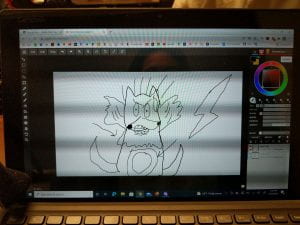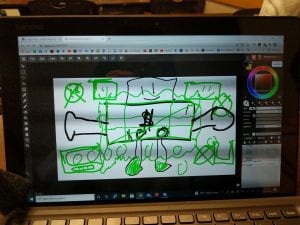This game can be played with any number of players above three, although one needs to be able to hear everybody speak if the game is to be played in person. Alternatively, this could also be played with an online chat system, which could allow for more players than the soft limit imposed by the aforementioned restriction.
First, pick two people to be competing against each other. One will be the drawer, and the other the saboteur. The rest of the group will be the guesser(s). These roles can be determined any way the group likes.
Then, pick a word or phrase. This word or phrase will be only known to the drawer and the saboteur, not the guesser(s).
Use an online tool that allows multiple people to draw on the same canvas simultaneously. This game will work with any software that allows for this. The best option out there currently and the one used for playtesting is aggie.io.
When everybody is ready to begin, the drawer starts drawing the word or phrase to the best of their ability. The guessers will attempt to guess the word or phrase from the drawing. The saboteur’s goal is to thwart the drawer and guessers by drawing on the canvas as well. The saboteur is not allowed to just cover up the drawing. The refereeing of this rule is up to the group. One way to discourage this behavior is to have the drawer’s drawing on top of the saboteur’s drawing. This is not foolproof as the saboteur can still effectively cover up drawings if they use the same color as the drawer (assuming the drawer only uses one color), so the refereeing is necessary. Additionally, if it is at all possible to view what one person draws separately from another, the guessers must abstain from that information. In aggie.io, this takes the form of layers. Each participant can only draw on one layer, so if one were to look at the layer previews, one can see what the drawer is drawing without the interference from the saboteur. This can be resolved by obstructing the guesser’s view of the layer previews.
Some tips for the saboteur:
- Use the same color and stroke thickness as the drawer to make your red herrings indistinguishable from the actual drawing
- Add elements that make the drawing appear to depict something else
- Add arrows pointing to unimportant areas of the drawing if you are especially devious
Some tips for the drawer:
- Use different colors relevant to the word/phrase
- You can restart the drawing in a blank space (if there’s any left) if what you’re currently working on in unsalvageable
Some tips for the guesser(s):
- Differences in color and brush stroke can tip you off that different people are drawing different parts
- Usually, the stuff closer to the center tends to be the drawer’s and the stuff surrounding it are the saboteur’s
The round ends when the guessers have correctly guessed the word or phrase or when the group collectively agrees to give up. If it took more than one minute to guess, the saboteur wins. If it took less than a minute to guess, the drawer wins. This time length can be adjusted if the group wishes but play testing has found that a minute is a good threshold for our group. For example, if the words or phrases being picked are consistently very difficult to draw, the group may want to extend that time, or shorten it if the words or phrases are easy to draw.
A new round can have the same people in the same roles, but we found it more fun to rotate the roles around so that everybody gets a chance to try every role.
Here are some of art created from play testing:

Husky

Eiffel Tower

Cash
Artist’s statement:
I knew I wanted to do a game where multiple people draw on the same canvas because of the child-like nature of it. I was also inspired by Yoko Ono’s scores that resulted in artwork being created, such as Painting to Hammer a Nail, and John Cage’s procedural pieces that were slightly different every performance. I liked the idea of creating art by following rules or instructions. In this game, art is constantly being created every round, and it is all done without the main focus being the creation of art, but rather defeating your opponent. I think this creates art that could be more spontaneous or organic. I also think shifting the focus away from the creation of art can help those hesitant about art be more free from their preconceptions about themselves. I was also intrigued with the idea of two parties clashing in a competition where one is declared winner. I enjoy competitive video games in my free time, and I wanted to include that competitive feeling into this game. I think I was successful, even though the game is very casual in its presentation. I feel like it strikes a good middle ground where some groups can get very into winning and losing and other groups can be more focused on the drawings instead. As for what I appropriated, I’ve appropriated drawing software to play this game, as well as other drawing games where people guess what others are drawing such as skribbl.io, garticphone.com, or the drawing version of charades.
